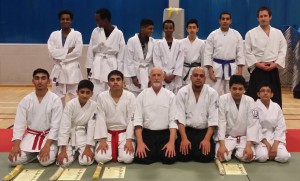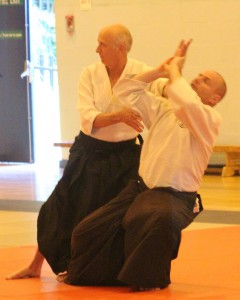The ‘Aikido Priest’ by Mark Peckett
 I remember an incident that happened many years ago when I was just starting out teaching aikido. I was holding my class in the local sports centre and we shared the changing room with all the other users of the centre. On this particular evening I was surrounded by a group of men who had just finished playing squash. My black belt was sufficiently new that I still got a thrill out of tying it on in public, but it was the hakama that drew the comments. One of the squash players said:
I remember an incident that happened many years ago when I was just starting out teaching aikido. I was holding my class in the local sports centre and we shared the changing room with all the other users of the centre. On this particular evening I was surrounded by a group of men who had just finished playing squash. My black belt was sufficiently new that I still got a thrill out of tying it on in public, but it was the hakama that drew the comments. One of the squash players said:
“Careful what we say, lads – we’ve got a priest in here!”
And we all laughed, me more self-consciously than them.
That happened over a quarter of a century ago and only came back to mind I set up my own organisation two years ago, because in that off-the-cuff remark, as with much humour, there is an element of truth.
I won’t deny that one of the motivations when I started practising aikido was to wear the hakama, because the dan grades certainly did look like priests. And that’s how we treated them; hanging on their every word as if they had not only mastered some techniques, but uncovered the secret of life itself!
Equally, when I started teaching, I was treated in the same way by kyu grades and I’d be lying if I didn’t say I liked it. As Koichi Tohei says in “Aikido in Daily Life”:
Sometimes people in the instructor’s seat want to swagger a bit. The truth is, just because someone is teaching he has not necessarily mastered all of the principles the universal has to teach … For an instructor to consider himself a perfected being is a ridiculous illusion. Conceit closes the eyes of the spirit and leads to regression rather than progress.
I believe you can see fairly clearly what a teacher is like by the way his students behave. Students tend to be a mirror. If the teacher swaggers, so will his students; but equally, bad habits I might find in my own students, may well be a reflection of my own.
Of course, I’m older now, hopefully wiser and less in need of quick ego boost. And being the head of an organisation makes you aware of your responsibilities in a way that teaching in someone else’s does not. And the greatest responsibility is to follow Bruce Lee’s dictum: “A good teacher protects his pupils from his own influence.”
As a teacher, I want my students to aspire be better than me. I don’t want them to think they can never live up to my example because I have some secret connection to the universe. I want them to ask me questions, because I want to test my own knowledge and skill. If I don’t have an answer, I mustn’t be afraid to admit it, or if a student comes up with a better answer than mine, I mustn’t be afraid to embrace it. My teaching must also be my learning.
Of course, it is easy to explain something without caring whether the person you are explaining to actually learns or not. But if a teacher wants to make progress they can do so through teaching, because that in itself is a form of learning. The author Richard Bach said:
We teach best what we most need to learn.
This is one of the reasons I am constantly returning to ikkyo in my own teaching! Again to quote Tohei:
A man does not have to be a good swimmer to be a good swimming coach. To be a good instructor one must kindly and enthusiastically teach others to the basic principles to the limits of his ability.
I encourage my students to go and practise with other clubs and instructors, not just to learn new techniques, but to see that my version is not the only one, and not even the necessarily the best one. To use an expression that Bruce Lee used in another context, “It’s like a finger pointing away to the moon. Don’t concentrate on the finger or you will miss all that heavenly glory.” It is important for the teacher to know that he is the finger and not the moon. And it is just as important for his students to realise that. O’Sensei himself said:
“Instructors can only impart a fraction of the teaching. It is through your own devoted practice that the mysteries of Aikido will [be] revealed.”
So we are all learning and growing together, and what we have learned, we should pass on. Koichi Tohei again:
Do not be stingy with a technique you have learned … If we give of what we have learned as much as we can we can learn still more.
This is why I study other arts, and go to courses and seminars run by other teachers. So that I can learn and then pass on what I understand, and in doing so deepen my own knowledge and understanding. When it comes down to it, we are all trying to make progress, and the best instructors are those who want to walk that path with others.
I have seen instructors who belittled their students verbally, or even struck them for delivering an incorrect attack. I suppose that they thought they were building character, although I believe students treated in this way will either lose heart, or they will make have to make themselves subservient to the instructor. They may think that in doing this they will gain access in time to the instructor’s secret teachings; in fact the only benefit going on here is to the instructor’s ego.
I know there is a Japanese proverb which says “the nail that sticks out gets hammered down” which is usually interpreted as “you should conform and follow the rules”, but it is not carte blanche to abuse one’s students. And anyway, if you chose to stand out in a crowd, that takes courage, so maybe the proverb is best translated into English as “Better to be hung as a sheep than a lamb”.
In short, I’m not a priest; I’m just someone who was fortunate enough to discover aikido and who wants to share some of the joy it has brought me with other people. I want students, not disciples, who will walk some of the aiki path with me before they discover their own.


